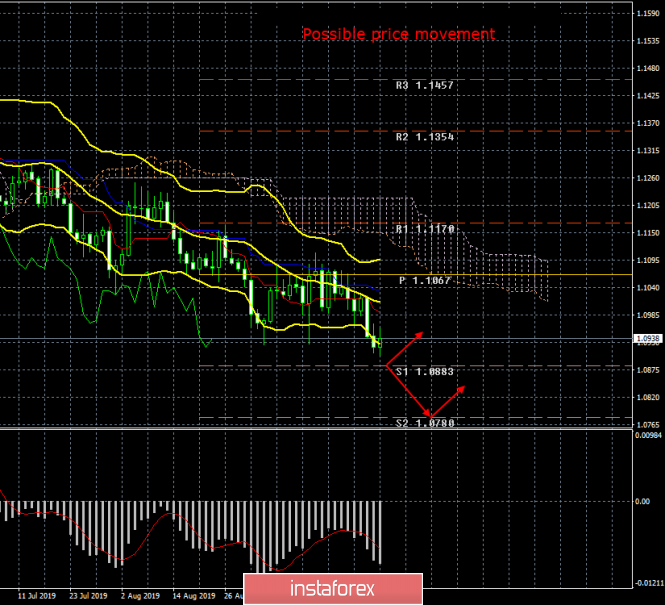24-hour timeframe

Another month ends on the forex market and today we can sum up some results. The situation has not changed much for the euro over the past month. The downward trend remains. The correction ended near the critical Kijun-sen line. The fundamental background both local and long-term has not changed. Thus, traders may well expect a continuation of the downward movement of the EUR/USD pair in October. Just based on the fact that nothing has changed in the balance of power between the euro and the dollar. Both the Federal Reserve and the European Central Bank lowered their rates, but the European regulator also announced the revival of the quantitative stimulus program. Moreover, at the end of the month Mario Draghi will officially resign, and Christine Lagarde will take his place. The new head of the central bank - it is always suspense and uncertainty, and the foreign exchange markets do not like her, often preferring not to risk "dangerous" events. Thus, the situation for the euro has even slightly worsened and in October the bears can continue to dominate the market.
Two important macroeconomic reports will be published next week. The first is a report on inflation in the European Union. Here traders can hardly hope for anything positive. Again, simply because no structural changes are taking place in the EU economy. Yes, the rate on deposits was lowered, but it took too little time for this factor to spur inflation. As for the QE program, it starts only in November. That is, it turns out that, purely theoretically, inflation in the EU may slightly accelerate, for example, by 0.1%. This may be an accident, or due to some seasonal product groups. But in general, inflation will remain unchanged at 1.0% or continue to decline further. In any case, the inflation report is unlikely to support the euro.
The second important report of the week is NonFarm Payrolls in the US. This report is important because it reflects the number of new jobs created in the country over the past month. One of the main engines of the US economy is precisely the constant development and growth of the labor market. The past value of the indicator was 130,000, the previous two months were a little more positive. In September, there are expectations from +140,000 to +175,000 new jobs outside the agricultural sector, according to various forecasts. But we would like to immediately note that, as in the case of European inflation, even if the real growth in September is below 140,000, this is unlikely to cause strong sales of the US dollar, as market participants are well aware that a monthly increase in the growth rate is impossible basically. Unemployment in the United States is at a very low level, so the overall labor market is in excellent condition. NonFarm growth is several thousand less than forecasted - this is not a big problem for the American economy. The peak that threatens the dollar is a local fall within the day.
So it turns out that there are no obstacles to the euro's decline. Of course, in any case, everything will depend on the mood of traders who may decide that buying the US dollar is more inappropriate, which will strengthen the pair, without visible fundamental reasons. But the likelihood of such an option is no more than 10%. A 90% probability that the pair will continue to move according to the main trend direction.
Trading recommendations:
The trend for the euro/dollar pair remains downward. Bears have updated two-year lows and are ready to continue to sell the pair with targets at 1.0883 and 1.0780. Thus, traders are encouraged to continue to stay in trend. It is not advisable to consider purchasing the euro yet.
In addition to the technical picture, fundamental data and the time of their release should also be taken into account.
Explanation of the illustration:
Ichimoku indicator:
Tenkan-sen is the red line.
Kijun-sen is the blue line.
Senkou Span A - light brown dotted line.
Senkou Span B - light purple dashed line.
Chikou Span - green line.
Bollinger Bands Indicator:
3 yellow lines.
MACD indicator:
Red line and bar graph with white bars in the indicator window.
The material has been provided by InstaForex Company - www.instaforex.com